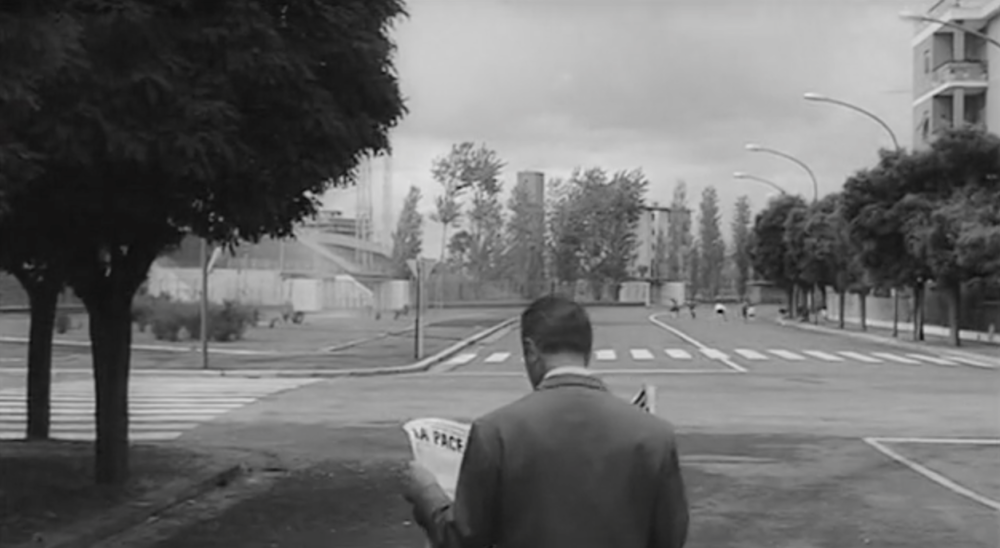Artist Blog
Every week an artist whose single image was published by Der Greif is given a platform in which to blog about contemporary photography.
About the interstice
Dec 02, 2016 - Diego Ballestrasse
In the decade from 1950 to 1960, the irruption of Italian Neorealism entails a significant turning point in the way space and time are treated in cinema, affecting the plot.
Gilles Deleuze has explained how, until that moment, the cinema is governed under the idea of the image-movement, analyzed on his study of cinema Cinéma I: L’image-mouvement (1983).This happens in such a way that the image in cinematographic movement obeys to the need to capture and reproduce actions that are organized in sequences of causes and effects: each image acts on others and reacts to others in a whole that integrates them: the script.
In that sense, Deleuze criticizes the image-movement considering it as a primitive cinema, developed basically within the stimulus and response scheme that governs its characters and the sequences of actions of their scripts. According to Deleuze, this type of film only stimulates the nervous system of its spectators at one sensory-motor level: its cerebellum, in which it produces laughter, sweat and tears. On the other hand, he argues that only by avoiding the scripts of films can the spectator fully contemplate their images, thus turning an experience conducted by a narrative function into a fully visual experience.
The difference between these two possible functions of the cinematographic image is also a difference of perception, especially of the spectator’s experience in relation to time. This is the case concerning the “dead time” in the films of Michelangelo Antonioni or Vitorio De Sica, in which there are images that do not lead to actions or are not explicitly relevant to the development of the script, analyzed in Cinéma II: L’image-temps (1985). This kind of drift from the script is kept for the treatment of time (the time that a scene lasts), as well as the space shown in the scene.
The Italian Neorealism incorporates elements that are usually “disposable” for the classic Hollywood directors. They occur when the protagonists leave the space but their camera does not follow them, nor the action is cut, the camera keeps shooting in the same space after the protagonist left empty, to stay with others who stayed or are about to enter. This way, the takes are maintained and diverted to include others; these “intermediate moments” seem to be essential, the time and space seem richer than the plot or the story.
In these terms, Kogonada defines the essence of Neorealism in this video-essay:
These “intermediate moments” that refer to the temporality of the image on the screen, we could also call “temporary interstices”, based on the passage of time during the scene. However, what happens to what is shown on the screen?
In that sense, Michelangelo Antonioni’s cinema uses unconventional and excessive framings, where his characters appear on one side or half hidden. Antonioni had studied USA abstract painting. His films looked like canvases of modern life in which people partially appear and his vision of empty spaces is related to a peripheral look. In his cinema, Antonioni explores and deepens the concept of emptiness as well as its visibility. According to John Berger, the Italian director’s interest “is always next to the event
shown”, in the words of Roland Barthes, “The artist stops and takes long looks, looks at things radically, until their exhaustion.”
In the famous ending of The Eclipse, Monica Vitti’s character leaves the film and never appears again. Instead, we see places, street corners where we had seen her with Alain Delon. Emptiness seizes everything. The world seems empty. As if all were dead or at home. We see this woman and we think that Vitti is back. But no, it is another restless passerby:
In The Fourth Wall, I explore this “space interstice” attending to the blind spots of photography, those which usually escape the eye. This device that allows me to photograph by placing the camera “within” the images, is not a simple frame within another frame: it is a subterfuge to alter the hierarchy of the established order within the image with regard to what is supposed to establish the meaning. It is a displacement of the attention of the gaze that goes from the explicit to the implicit, from what could be obvious to what is ambiguous, to discover spaces that do not lead to actions or not are explicitly relevant to the understanding or development of the argument proposed by the image.
As a consequence, images from the family archive are “born” like fractals, images that were inside the original image. Through this process, I go through the two-dimensional image at the same time as this is transformed into a deep space, in a three-dimensional scenario.
For all this, this project allows us to reflect to what extent it is possible to expand the way in which we relate to the family album and, by extension, to any image we feel linked to.


